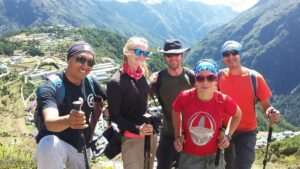TREKKING PEAK CLIMBING IN NEPAL

Trekking Peak Climbing in Nepal – The Ultimate Adventure for Climbers
If you are looking for an adventurous
trekking peak climbing in Nepal, the majestic mountains of this Himalayan nation offer an unparalleled experience. Climb some of the most challenging yet rewarding trekking peaks to take your adventure to the next level.
Currently,
27 trekking peaks in Nepal ranging from
5,849m to 6,584m are classified as "Trekking Peaks" by the
Nepal Mountaineering Association (NMA). The NMA promotes mountain tourism and issues climbing permits for these peaks. In 2002, several new trekking peaks were added and categorized into two groups:
- Group A (NMA Expedition Peaks) – Newly classified trekking peaks with 12 mountains, including Cholatse, Kyazo Ri, and more.
- Group B (NMA Climbing Peaks) – Includes 15 trekking peaks such as Mera Peak, Kusum Kanguru, and others.
Below is a detailed list of
trekking peak climbing in Nepal, categorized by region and NMA group.
Group A (NMA Expedition Peaks) – Everest Region
1. Mt. Cholatse (6,440m/21,123ft)
Located between the
Khumbu and Gokyo valleys,
Cholatse Peak is a challenging climb known for its steep ridges and narrow snow-covered paths. The trek route starts from
Lukla to Namche Bazaar, then continues to
Pheriche village, leading up to the summit.
2. Mt. Phari Lapcha (6,273m/20,575ft)
Also known as
Machermo, this peak is situated in the
Gokyo Valley of the
Khumbu region. The climb is technical, and the steep
north face makes it a tough ascent. From the summit, climbers can enjoy breathtaking views of
Everest, Lhotse, Amadablam, and Nuptse.
3. Mt. Kyajo Ri (6,186m/20,290ft)
A
classic trekking peak climbing in Nepal, Kyajo Ri is located
north of Namche Bazaar. The climb is highly challenging, but the stunning views from the
Kyajo Drangka valley make it worth the effort.
4. Mt. Nirekha (6,159m/20,201ft)
Situated near the
Tibetan border,
Mt. Nirekha offers a moderate trekking peak climbing in Nepal experience. Although the climb is straightforward,
climbers require crampons, an ice axe, and ropes to ascend safely.
5. Mt. Ombigaichen (6,340m/20,795ft)
Also called
Puma Dablam, this peak lies
southeast of Ama Dablam. Climbers start from
Namche Bazaar, trekking to the
Ama Dablam base camp before reaching the summit. The panoramic views of
Everest, Lhotse, Nuptse, Makalu, and Ama Dablam make it a stunning adventure.
6. Mt. Abi (6,097m/19,998ft)
This twin-peaked mountain, also known as
Kangchung Shar and Kangchung Nup, is located in the
Gokyo Valley. The climb is adventurous yet
technically difficult, making it suitable for
experienced climbers only.
7. Mt. Lobuche West (6,145m/20,156ft)
The
Lobuche mountain range consists of two peaks:
Lobuche East (6,119m), a trekking peak, and
Lobuche West (6,145m), classified as an
expedition peak by the NMA. The west peak is rarely climbed due to its
technical challenges.
Group B (NMA Climbing Peaks) – Everest Region
8. Island Peak / Imja Tse (6,173m/20,252ft)
Island Peak is one of the
most popular trekking peak climbing in Nepal. The ascent is demanding, with
crevasses and technical sections. Climbers often take an acclimatization trek to
Lobuche or Kala Pattar before attempting the peak.
9. Mera Peak (6,476m/21,246ft)
As the
highest trekking peak climbing in Nepal,
Mera Peak is both a trekking and mountaineering challenge. The ascent involves crossing
glaciers and steep ice walls, requiring
ice axes, crampons, and fixed ropes.
10. Lobuche East (6,105m/20,029ft)
Lobuche East is a
technical trekking peak, located near
Everest Base Camp. The ascent requires
two days of training and is often used for acclimatization before
Everest expeditions.
11. Kongma Tse (5,817m/19,084ft)
Also called
Mehra Peak, this summit lies
north of Kongma La and forms part of the
Nuplse mountain range. It is an ideal
training peak for mountaineers aiming for
higher elevations.
12. Kongde Ri (6,187m/20,298ft)
Visible from
Namche Bazaar,
Kongde Ri is a stunning ridge of summits. The climb offers
a panoramic view of Everest and is one of the
best trekking peak climbing experiences in Nepal.
13. Kusum Kanguru Peak (6,369m/20,895ft)
This
technically challenging peak near
Lukla is among the
toughest trekking peaks in Nepal. It requires
strong mountaineering skills and
ice-climbing experience.
14. Pokalde Peak (5,794m/19,009ft)
Pokalde does not require a
climbing permit as it is below
5,800m, making it an
accessible peak for beginner climbers. It is best climbed via the
Kongma La Pass route.
Why Choose Trekking Peak Climbing in Nepal?
Nepal is home to some of the
best trekking peaks in the world, offering both beginners and experienced climbers a chance to
test their skills in the Himalayas. From the
technical ascents of Kyajo Ri and Kusum Kanguru to the
popular routes of Mera Peak and Island Peak, Nepal’s trekking peaks offer
breathtaking landscapes, high-altitude adventure, and unforgettable experiences.
Best Time for Trekking Peak Climbing in Nepal
The
ideal seasons for
trekking peak climbing in Nepal are:
- Spring (March-May) – Stable weather and clear views.
- Autumn (September-November) – Best climbing conditions with dry trails and warm temperatures.
Final Thoughts
If you're seeking an
unparalleled trekking peak climbing experience in Nepal, these 27 trekking peaks offer the
perfect mix of adventure, challenge, and stunning views. Whether you aim to
train for an 8,000m peak or simply want to
enjoy the thrill of Himalayan climbing, Nepal’s
trekking peaks are the best place to start.
These peaks serve as an excellent introduction to high-altitude mountaineering, offering both technical challenges and accessible routes for climbers of varying skill levels. Each mountain tells its own story, from the iconic Mera Peak with its panoramic views of five 8,000m giants to the technically demanding Lobuche East that tests even seasoned climbers.
These peaks represent not just climbing challenges, but gateways to understanding Nepal's rich mountain heritage and your own capabilities. Whether this is your first step into mountaineering or another chapter in your climbing journey, Nepal's trekking peaks promise adventures that will stay with you long after you've returned home..
